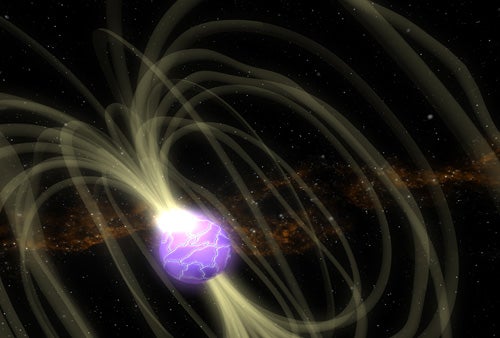The blast originated from a highly magnetized neutron star called a magnetar. The object, designated SGR 1806-20, lies 50,000 light-years away in the constellation Sagittarius, on the other side of our galaxy. The remnant of a massive star that exploded as a supernova, a neutron star packs our Sun’s mass and more into a ball less than 15 miles (24 kilometers) wide. A rare breed of neutron star, a magnetar sports magnetic fields 1,000 times stronger than normal. Of the 1,500 neutron stars astronomers have cataloged, only 14 rank as magnetars.
“This might be a once-in-a-lifetime event for astronomers, as well as for the neutron star,” says David Palmer of Los Alamos National Laboratory, who analyzed the flare using NASA’s Swift satellite. “We know of only two other giant flares in the past 35 years, and this December event was 100 times more powerful.”
The radiation struck Earth as a spike of gamma rays, followed by a tail of X rays and radio waves. The Russian satellite Coronas-F was behind Earth at the time and unable to detect the outburst directly, yet it picked up radiation reflected off the Moon. The sudden surge of gamma rays heated Earth’s ionized upper atmosphere and caused it to expand. A dozen amateur astronomers who were monitoring radio waves passing through the ionosphere noticed and reported this disturbance.
Scientists believe the intense magnetic fields within a magnetar become twisted, straining its outer crust, which eventually fractures in a “starquake.” The result is a sudden rearrangement of the external magnetic field and an enormous outpouring of energy — a magnetar flare. As energetic matter violently collides with surrounding gas, it creates a glowing, expanding, radio-emitting bubble. Ground-based radio observatories in the United Kingdom, India, the Netherlands, Australia, and the United States detected this radio afterglow and showed the bubble to be expanding at about a quarter of the speed of light.
According to Bryan Gaensler of the Harvard-Smithsonian Center for Astrophysics, who studies the radio nebula using the Very Large Array in New Mexico, scientists may be able to monitor the afterglow until 2020.
Astronomers studying the flare’s fading X rays noted a repeating pattern with a spike every 7.56 seconds — apparently, this is the magnetar’s rotation period. Astrophysicists Tod Strohmayer at NASA’s Goddard Space Flight Center in Greenbelt, Maryland, and Anna Watts at the Max Planck Institute for Astrophysics in Garching, Germany, looked still closer, at oscillations at particular X-ray frequencies detected by NASA’s Rossi X-ray Timing Explorer (RXTE).
They believe X-ray changes at 26 Hz and 90 Hz reflect the twisting of shear waves as they traveled around the magnetar. Likewise, higher-frequency 626 Hz oscillations signaled the rise and fall of the neutron star’s crust. They confirmed the RXTE measurements with another satellite observatory, NASA’s Ramaty High Energy Spectroscopic Solar Imager.
The researchers used this information to estimate the neutron star’s rigid crust — about 1/12th the star’s diameter, or about a mile (1.6 kilometers) thick. They presented their findings at the April meeting of the American Physical Society, in Dallas.
Just as earthquake waves let geophysicists explore Earth’s interior structure, and sound waves reveal the Sun’s interior, astronomers hope to use future outbursts to probe neutron stars. Future spacecraft optimized to detect key oscillations may revolutionize our understanding of these superdense stars and the exotic matter within them.










